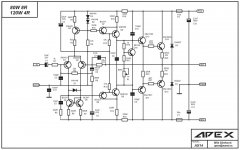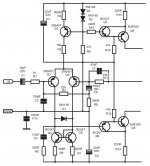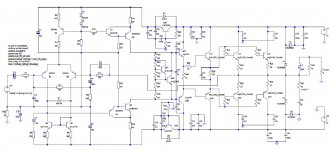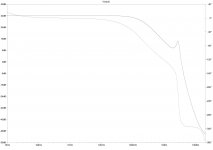I was basing it on my memory of Self's detailing of FETs from his book. If this is incorrect due to faulty models then that is fine.
Possible output transistors
Here is a minor update to my list of possible output transistors. I am trying to keep the list to transistors that are not obsolete, however some may not be stocked by most distributors. I am also sticking to only listing Bipolar transistors for the time being, even though there has been success in using MOSFETs as outputs.
If anyone is aware of any other appropriate transistors, let me know. The same with any I have listed that may actually be inappropriate.
I have removed MJL21193/4, for being potentially too slow for the SlewMaster.
For any of the outputs that have a fT greater than 30MHz it might be a good idea to run drivers of equal or faster fT. Using an extra pair of your chosen outputs as the driver pair would work for this purpose.
Sanken MT-200 packages are extra wide (37mm) and will require skipping outputs on the 5 or 3 pair boards to be usable.
Toshiba: (avalable from Mouser and Digikey)
2SC5200/2SA1943 230V 150W 30MHz TO-264
2SC5242/2SA1962 230V 130W 30MHz TO-3P
Fairchild: (avaliable from Mouser and Digikey)
FJL4315/FJL4215 Toshiba 2SC5200/2SA1943 copy 250V
FJA4313/FJA4213 Toshiba 2SC5242/2SA1962 copy 250V
On Semi: (avalible from Mouser, Digikey, and Newark/Farnell)
NJW0281/NJW0302 250V 150W 30MHz TO-247
NJW3281/NJW1302 250V 200W 30MHz TO-247
MJL3281/MJL1302 250V 200W 30MHz TO-264
MJL4281/MJL4302 350V 230W 35MHz TO-264
Semelab: (avalible from Profusion and Newark/Farnell)
MG6330/MG9410 230V 200W 35MHz TO-3P
MG6330-R/MG9410-R 260V 200W 35MHz TO-3P
MG6331/MG9411 230V 300W 35MHz TO-3P
MG6331-R/MG9411-R 260V 300W 35MHz TO-3P
MAG6332/MAG9412 230V 400W 35MHz TO-264
MG6333-R/MG9413-R 260V 400W 35MHz TO-264
Sanken: (available from Digikey, Profusion, and Newark/Farnell)
2SC6145A/2SA2223A 260V 160W 35MHz MT-100/TO-3
2SC3263/2SA1294 230V 130W 35MHz MT-100/TO-3P
2SC3264/2SA1295 230V 200W 35MHz MT-200
2SC3519/2SA1386 160V 130W 40MHz MT-100/TO-3P (70V rails max)
2SC2922/2SA1216 160V 200W 40MHz MT-200 (70V rails max)
2SC2921/2SA1215 160V 150W 50MHz MT-200 (70V rails max)
2SC3284/2SA1303 150V 125W 50MHz MT-100/TO-3P (60V rails max)
Here is a minor update to my list of possible output transistors. I am trying to keep the list to transistors that are not obsolete, however some may not be stocked by most distributors. I am also sticking to only listing Bipolar transistors for the time being, even though there has been success in using MOSFETs as outputs.
If anyone is aware of any other appropriate transistors, let me know. The same with any I have listed that may actually be inappropriate.
I have removed MJL21193/4, for being potentially too slow for the SlewMaster.
For any of the outputs that have a fT greater than 30MHz it might be a good idea to run drivers of equal or faster fT. Using an extra pair of your chosen outputs as the driver pair would work for this purpose.
Sanken MT-200 packages are extra wide (37mm) and will require skipping outputs on the 5 or 3 pair boards to be usable.
Toshiba: (avalable from Mouser and Digikey)
2SC5200/2SA1943 230V 150W 30MHz TO-264
2SC5242/2SA1962 230V 130W 30MHz TO-3P
Fairchild: (avaliable from Mouser and Digikey)
FJL4315/FJL4215 Toshiba 2SC5200/2SA1943 copy 250V
FJA4313/FJA4213 Toshiba 2SC5242/2SA1962 copy 250V
On Semi: (avalible from Mouser, Digikey, and Newark/Farnell)
NJW0281/NJW0302 250V 150W 30MHz TO-247
NJW3281/NJW1302 250V 200W 30MHz TO-247
MJL3281/MJL1302 250V 200W 30MHz TO-264
MJL4281/MJL4302 350V 230W 35MHz TO-264
Semelab: (avalible from Profusion and Newark/Farnell)
MG6330/MG9410 230V 200W 35MHz TO-3P
MG6330-R/MG9410-R 260V 200W 35MHz TO-3P
MG6331/MG9411 230V 300W 35MHz TO-3P
MG6331-R/MG9411-R 260V 300W 35MHz TO-3P
MAG6332/MAG9412 230V 400W 35MHz TO-264
MG6333-R/MG9413-R 260V 400W 35MHz TO-264
Sanken: (available from Digikey, Profusion, and Newark/Farnell)
2SC6145A/2SA2223A 260V 160W 35MHz MT-100/TO-3
2SC3263/2SA1294 230V 130W 35MHz MT-100/TO-3P
2SC3264/2SA1295 230V 200W 35MHz MT-200
2SC3519/2SA1386 160V 130W 40MHz MT-100/TO-3P (70V rails max)
2SC2922/2SA1216 160V 200W 40MHz MT-200 (70V rails max)
2SC2921/2SA1215 160V 150W 50MHz MT-200 (70V rails max)
2SC3284/2SA1303 150V 125W 50MHz MT-100/TO-3P (60V rails max)
Last edited:
I'm afraid I don't know what the Miller compensation is. Looking a at this one, it is very close to what BV did except for a 1K resistor from PD/ND to the feedback loop and one extra 100p cap per side. However those are not in the original design.
I took some time and set up the BJT OPS and MOSFET OPS side by side and hooked them up to my A/B setup. There are couple of differences. I didn't have identical transformers available so the MOSFET setup is running on 71V rails and the BJT setup is running on 57V rails. The MOSFET is using the BV modded CFA-XH IPS and the BJT setup is using the unmodded CFA-XH IPS. The weird thing is, the BJT setup with the lower rails is actually slightly louder at the same volume control settings. The MOSFET setup needs a slight boost to match. Maybe the gain is different between the two IPS. I didn't think of it before but tomorrow I will hook them up so both left channels have the unmodded CFA and the right channels have the BV Modded CFA so they will be identically fed.
So, here is my review. I am truly blessed! These two amps sound incredible! If you can hear a difference, you have super sonic hearing because there is just absolutely nothing missing in either of them. Clear sweet highs. The cymbals sound like they are hanging in the room. Drums are beautiful, from the snare right down through each drum to the bass. They are sitting right in front of you. Rich, grabbing guitar solos. Vocals are beautiful, female and male. Gerry Mulligan's Bari is something to behold. Funny, some of his tracks were re-mixed down from vinyl. You can hear the needle in the groove. Everything sounds as it should.
Have no fear, by my ear, you can build either OPS and not be disappointed. Stellar!
Blessings, Terry
Terry if you would need to pick one amplifier for the rest of your life it would be these or the Honey B.
More interested on the sound of the amp not the simplicity etc.🙂
You can send me PM in case if you do not want to post your answer here
Thank you
Greetings Gabor
SlewMaster
Jaagut your job is excellent .
SLEWMASTER Build
Regards Nikos
Yes just a few turns, make it twice for the 2 rails.
In my build I will make a trafo with boosted output +/-10 volts above the OPS rails for the IPS.
Jaagut your job is excellent .
SLEWMASTER Build
Regards Nikos
Terry if you would need to pick one amplifier for the rest of your life it would be these or the Honey B.
More interested on the sound of the amp not the simplicity etc.🙂
You can send me PM in case if you do not want to post your answer here
Thank you
Greetings Gabor
If I had to select between the two I would probably go with the Honey Badger because it takes less real estate. I think the Slewmaster is easier to build. (Less choices need to be made). To my ear, the HB sounds just as good. But for what I do, the Slewmaster is an awesome piece of equipment. Seems the IPS topology is endless with it and now that Valery came up with the MOSFET output it just keeps getting better.
Tough choice now that I think about it.
Mr. Self hate mosfet.
Mr. Cordell love it 😀
I have VSSA variant, using lateral mosfet. It is sound good.
Now, I want to try BIGBT.
M. Leach, John Curl etc..dislikes mosfets as outputs, but john curl used mosfet drivers...
The paradox of choice...
It's a funny thing, choices that is. It has been an observation that is recognized in the retail sector that when confronted with more than a couple options a prospective buyer will often fail to choose at all and leave without a purchase. This has been called the 'Paradox of Choice'. We think we want a bunch of choices in life and when actually offered choices we then fail to actually decide.
I hope that isn't what is happening here. We have a number choices and options which is expanding, albeit slowly. The goal is to build and compare, not so much to choose. Not sure about MOSFETs as outputs? Build a 2P OPS and decide for yourself. Not sold of the merits of a CFA? Build one of the CFA IPSs and compare. If you hit upon a combination that represents aural nirvana then box it up and put it in your system.
I do not have equipment adequate for making worthwhile measurements, but it appears there isn't much difference in both the objective measurements of others and the subjective experience between using BJTs or MOSFETs in the output stage. An individual builder can now make the choice based on their own past experience or preference and build the SlewMaster either way. Sometimes choice is good.
It's a funny thing, choices that is. It has been an observation that is recognized in the retail sector that when confronted with more than a couple options a prospective buyer will often fail to choose at all and leave without a purchase. This has been called the 'Paradox of Choice'. We think we want a bunch of choices in life and when actually offered choices we then fail to actually decide.
I hope that isn't what is happening here. We have a number choices and options which is expanding, albeit slowly. The goal is to build and compare, not so much to choose. Not sure about MOSFETs as outputs? Build a 2P OPS and decide for yourself. Not sold of the merits of a CFA? Build one of the CFA IPSs and compare. If you hit upon a combination that represents aural nirvana then box it up and put it in your system.
I do not have equipment adequate for making worthwhile measurements, but it appears there isn't much difference in both the objective measurements of others and the subjective experience between using BJTs or MOSFETs in the output stage. An individual builder can now make the choice based on their own past experience or preference and build the SlewMaster either way. Sometimes choice is good.
Hi Guys,
I recently built an Apex AX-14. Nice little amp. I have extra boards so I thought I would try using one for a Slewnmaster IPS. I tried loading it in spice and it seems to work but for some reason, the positive side pulls the CM down about 1.5V more than the negative rail. Maybe one of you can look it over and see if I've done it right.
Thanks, Terry
I recently built an Apex AX-14. Nice little amp. I have extra boards so I thought I would try using one for a Slewnmaster IPS. I tried loading it in spice and it seems to work but for some reason, the positive side pulls the CM down about 1.5V more than the negative rail. Maybe one of you can look it over and see if I've done it right.
Thanks, Terry
Attachments
Hi Guys,
I recently built an Apex AX-14. Nice little amp. I have extra boards so I thought I would try using one for a Slewnmaster IPS. I tried loading it in spice and it seems to work but for some reason, the positive side pulls the CM down about 1.5V more than the negative rail. Maybe one of you can look it over and see if I've done it right.
Thanks, Terry
Something isn't right...
Have you taken a look at the closed loop gain plot? I get a "nice" peak here. Do you get the same? A peak suggests instability somewhere.
See attached...
It's taken my interest but its late here... I'll have a better look, hopefully, tomorrow
Attachments
Hi Mcd99uk,
Thanks for looking.
No I don't know how to check for that. I usually just try stuff in spice to give me a place to check my voltages. Any idea why the positive and negative rails are different?
Thanks, Terry
Thanks for looking.
No I don't know how to check for that. I usually just try stuff in spice to give me a place to check my voltages. Any idea why the positive and negative rails are different?
Thanks, Terry
Hi Mcd99uk,
Thanks for looking.
No I don't know how to check for that. I usually just try stuff in spice to give me a place to check my voltages. Any idea why the positive and negative rails are different?
Thanks, Terry
No problem. 🙂
Your differing voltages are caused by a missing resistor in the lower cap multiplier.
Paul
I missed that. That fixed it. Looks like it runs OK now. Looking forward to what you find. It would be nice to know if I need to change something before I build it.
Blessings, Terry
Blessings, Terry
This peak is rather expected - EF3 OPS (like SlewMaster) introduces additional pole in the system, which was not the case in the original AX-14 (EF2). Mcd99uk is right - the way it is, it may cause instability and requires additional compensation. This pole will not "disappear", but may be smoothed and moved to the right and down on the curve, ensuring the unity gain level is crossed with 6 db/dec slope.
There are lots of possibilities though - original AX-14 utilizes only a lead cap in parallel with GNFB resistor (and this "minimalistic" approach to compensation is one of the beauties of it, I believe), so additional RC at IPS or VAS, and/or some Miller caps are possible cures (I can't tell anything more particular at the moment as I normally use Multisim and would need to re-draw the schematic for simulation) - I think Mcd99uk will handle it right 😉
Terry, this is not a big issue - just needs to be addressed. In overall, the setup is workable.
Cheers,
Valery
There are lots of possibilities though - original AX-14 utilizes only a lead cap in parallel with GNFB resistor (and this "minimalistic" approach to compensation is one of the beauties of it, I believe), so additional RC at IPS or VAS, and/or some Miller caps are possible cures (I can't tell anything more particular at the moment as I normally use Multisim and would need to re-draw the schematic for simulation) - I think Mcd99uk will handle it right 😉
Terry, this is not a big issue - just needs to be addressed. In overall, the setup is workable.
Cheers,
Valery
Thanks Guys,
I just have some empty boards right now so adding is easy. The goal here for me is to learn. I look at the schematic and looks like it is an EF2. It ties in pretty much the same as the Slewmaster. I just built the AX-14 and the SX-14 (MOSFET), inspired by you Valery. 😉 post #3342
I have already built most of the OS IPS's and your hybrid. Just seems natural now to try something else. I'll wait to start until you guys have had a chance to give it a good look.
One thing that will have to be dealt with is the fact that the AX14 is pretty high gain. Seems like the Slewmaster doesn't like that. Might have to lower that. If nothing else we can keep the thread alive while we wait for OS to return. 🙂
Blessings, Terry
I just have some empty boards right now so adding is easy. The goal here for me is to learn. I look at the schematic and looks like it is an EF2. It ties in pretty much the same as the Slewmaster. I just built the AX-14 and the SX-14 (MOSFET), inspired by you Valery. 😉 post #3342
I have already built most of the OS IPS's and your hybrid. Just seems natural now to try something else. I'll wait to start until you guys have had a chance to give it a good look.
One thing that will have to be dealt with is the fact that the AX14 is pretty high gain. Seems like the Slewmaster doesn't like that. Might have to lower that. If nothing else we can keep the thread alive while we wait for OS to return. 🙂
Blessings, Terry
I'm sure there is still lots to keep the thread alive with, though I would like to see ostripper return sooner rather than later.
One thing needed is to develop a good standardized PSU for the whole platform to run on. I've posted a few thoughts on this and when I have finally finished the IPSs I will turn my attention to the 'auxiliary' components. It would be nice to have one consistent flavour for the whole project, one stop shop as it is said.
I also like the idea of a couple of very minimalist IPSs. I'd suggest a bare bones 'Blameless-like' and a really stripped down VSSA. Kinda like a giant PeeCeeBee. This would be to try and showcase the differences rather than develop the n-th degree and bring them to a level of sameness.
One thing needed is to develop a good standardized PSU for the whole platform to run on. I've posted a few thoughts on this and when I have finally finished the IPSs I will turn my attention to the 'auxiliary' components. It would be nice to have one consistent flavour for the whole project, one stop shop as it is said.
I also like the idea of a couple of very minimalist IPSs. I'd suggest a bare bones 'Blameless-like' and a really stripped down VSSA. Kinda like a giant PeeCeeBee. This would be to try and showcase the differences rather than develop the n-th degree and bring them to a level of sameness.
Another interesting and useful point - soft-start and protection system.
I've got a mature solution that I use for my amps. It's not the simplest one, but covers all the required functions and very flexible (you can change delays and even protection algorithm easily - good, for example, for hybrids, where you normally need additional relay and longer delays). I can share the latest version if you think it's appropriate.
Cheers,
Valery
P.S. Yes, we miss OS, but got some things to do while he is away 😉
I've got a mature solution that I use for my amps. It's not the simplest one, but covers all the required functions and very flexible (you can change delays and even protection algorithm easily - good, for example, for hybrids, where you normally need additional relay and longer delays). I can share the latest version if you think it's appropriate.
Cheers,
Valery
P.S. Yes, we miss OS, but got some things to do while he is away 😉
Last edited:
Another interesting and useful point - soft-start and protection system.
I've got a mature solution that I use for my amps. It's not the simplest one, but covers all the required functions and very flexible (you can change delays and even protection algorithm easily - good, for example, for hybrids, where you normally need additional relay and longer delays). I can share the latest version if you think it's appropriate.
Cheers,
Valery
P.S. Yes, we miss OS, but got some things to do while he is away 😉
I would like to see it. The hybrid is kind of a pain to use without something like that.
Now, what about the AX IPS? 😀
Since we now have so many working solution to the input section and now even a working Mosfet design I would love to see some work on the power supplies needed for the different levels whether they are single output pairs or the 5-pairs output. Some will want to go with the smps direction, ala Lazy Cat and the VSSA or the newer one and others may want to use a simple non regulated linear supply vs a regulated design.
I have a personal quest I would like to see for a commercial reason. Could someone here with the skills design a single board with however many output devices selected that would use surface mounted device and combined with the larger output devices such as Lazy Cat did with his original VSSA? I love the idea and design of these amps but would like to see it in a smaller package. Yes I know many would not want to diy such an animal but there are some who seem to be okay with doing surface mount as long as they are not the smallest devices. Just something I have been thinking about. I am thinking of the CFA-XH version and allowing for the full five output devices on the output section for now.
I have a personal quest I would like to see for a commercial reason. Could someone here with the skills design a single board with however many output devices selected that would use surface mounted device and combined with the larger output devices such as Lazy Cat did with his original VSSA? I love the idea and design of these amps but would like to see it in a smaller package. Yes I know many would not want to diy such an animal but there are some who seem to be okay with doing surface mount as long as they are not the smallest devices. Just something I have been thinking about. I am thinking of the CFA-XH version and allowing for the full five output devices on the output section for now.
Last edited:
Mounting output transistors horizontally?
Another desirable feature could be to produce an alternative layout for the baby slewmaster. With only two pairs of outputs per channel, has anyone considered an in-line mounting approach? Otherwise heatsink "real estate" becomes a little excessive!
Another desirable feature could be to produce an alternative layout for the baby slewmaster. With only two pairs of outputs per channel, has anyone considered an in-line mounting approach? Otherwise heatsink "real estate" becomes a little excessive!
- Home
- Amplifiers
- Solid State
- Slewmaster - CFA vs. VFA "Rumble"



